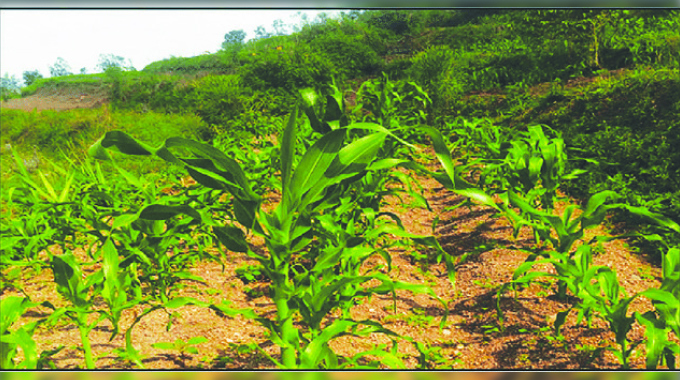Forest restoration: a path to recovery and well-being

Fortunes Matutu
Forests and trees contribute to food security and well-being through provision of ecosystem services, foods, income generation and habitat for wildlife.
They are the foundation and safety net of rural subsistence and have innate potential to contribute towards socio-economic enhancement and food security. Furthermore, the forestry sector produces essential products and services such as fresh air, nutritious foods, medicines and clean water which underpin public health the world over. Unfortunately, due to over exploitation Zimbabwe is losing 262 349 hectares of forest land to deforestation each year.
The major drivers of deforestation are clearing land for agriculture, settlement expansion, firewood cutting, mining activities, veld fires and illegal logging activities. Forest degradation and other disturbances in nature has brought about climate change, increased natural disasters and emergence of new pandemics. We must learn and adapt fast to global crises being caused by nature. Nature is communicating to us as people.
Ultimately if we don’t listen, we will perish. The solution lies in forest restoration. Without protecting and taking care of our forests, we put our lives in danger and that other flora and fauna. Everything within nature has to be conserved because they form ecosystems that are deeply connected in supporting lives and climate regulation.
COVID-19 has shown that when we abuse nature and destroy biodiversity, we destroy the system that supports human life. A study conducted in 2020 found that deforestation could lead to a rise in occurrence of diseases like COVID-19 in the future (Bloomfield, 2020).
The studies’ findings suggest that when forests are cleared, the chances of transmission of zoonotic diseases increase. The more biodiverse an ecosystem is, the more difficult it is for a pathogen to spread rapidly or dominate. Loss of biodiversity provides an opportunity for pathogens to pass between animals and people. For this reason, our best vaccine for the future is forest restoration to protect nature and biodiversity.
The global pandemic has also shown us the importance of forests and the need to restore them. Some of the essential personal protective equipment being used by the health systems are forest products for example, masks which utilize wood pulp and soluble cellulose fiber from the trees.
Other products include toilet paper, paper towels, tissues and ethanol for sanitizers, which may all be derived from trees. Investing in forest and ecosystem restoration will help in the well-being of individuals, communities and the environment. Reduction of forest loss, fragmentation and creation of buffer zones could reduce human-wild animal interactions and thus reduce the risk of future disease outbreaks.
Furthermore, the restoration and sustainable management of forests will also address climate change and biodiversity predicaments simultaneously while producing goods and services needed for the people.
Forest restoration are practices aimed to re-instate ecological processes which accelerate their regeneration, ecological functioning and biodiversity while continuously delivering benefits to generation. Restoration work focuses on bringing back natural processes that contribute to the forest’s productivity.
The best approach to forest restoration should consider human needs in that area while considering other forms of biodiversity and the drivers of deforestation in that area. As we deal with drivers of deforestation, people need look at ways to incorporate forestry in what they do such as agroforestry in agriculture and urban forestry to city planners. This requires starting with a diagnostic exercise to find out the causes because the appropriate approach to forest restoration depends on them.
Elements of forest restoration
*Tree planting – Most re-afforestation activities need to start with tree planting. This done using either tree seedlings or seedballs. Seedballs have emerged as an innovative way to achieve large scale afforestation and restoring of degraded landscapes. Tree planting doesn’t necessarily have to be replacing the same tree species that were there before.
One can grow non-native tree species and other native tree species without causing the extinction of local animals or plants while also providing benefits to people. Tree planting initiatives are important in establishing woodlots, woodlands, orchards and green belts.
*Farmer managed natural regeneration – This is a low-cost option to forest restoration. It involves management or protection of an area to allow systematic regeneration and management of trees and shrubs from tree stumps, roots, wildlings and seeds. The farmer can assist the regeneration by conducting several silvicultural practices like pruning, pollarding, thinning and enrichment planting and removing undesirable species such as invasive alien trees.
*Land management – Successful restoration must address land degradation and soil loss. Environmental works can be done to control soil erosion and gullies such as storm drains, contour ridges, gabion and silt traps. Agro-forestry can also be adopted as a technique for more productive and sustainable land use.
*Improving soils structure – Soils need microbes and soil organisms such as earth worms, centipedes and beetles to be productive. Adding organic matter to the soil can radically change a forest and support restored forest health by proving good environment for nutrient recycling and water retention.
*Enhance forest law enforcement and governance systems at community level and national level to combat deforestation and illegal trade in wildlife. Community level leadership needs to set up environmental management committees and work together with traditional leadership to formulate and enforce by laws which will promote forest restoration. Forest restoration needs active participation of the people involved either directly or indirectly.
The efforts can only succeed when experts and conservationists deeply engage with the communities who depend on the forests in question. If it does not involve them, then restored forests are likely to be degraded again. Any forest management plan also needs to enact ways to provide people with sustainable access to the forest resources they depend on to sustain their livelihoods.
*Fortunes Matutu is a forester with the Forestry Commission and has a special interest in social forestry.










Comments